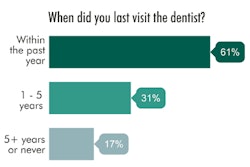
In 2013, about 42% of the U.S. population saw a dentist. But what will happen in 2017 or 2026? Will the number of dental visits by Americans increase or decrease through the next decade?
That is the question two economists and a dental public health researcher wanted to answer in a new study in Health Affairs. The researchers sought to see how demographic trends and healthcare policy will affect future use of dental care.
"During the past 20 years, there has been a shift toward fewer treatment procedures, such as restorative and surgical procedures, and more diagnostic or preventive procedures," the authors wrote (Health Affairs, December 2016, Vol. 35:12, pp. 2183-2189).
The study was led by Chad Meyerhoefer, PhD, an associate professor in the department of economics at Lehigh University in Bethlehem, PA. His co-authors were Irina Panovska, PhD, an assistant professor of economics also at Lehigh University, and Richard Manski, DDS, PhD, a professor and the chair of the department of dental public health at the University of Maryland School of Dentistry in Baltimore.
Small percentage increases
While the Patient Protection and Affordable Care Act (ACA) has provided a boost in the number of pediatric dental visits since it became law, the study authors wanted to see how demographic trends and healthcare policies in the U.S. will impact dental care use over the next decade.
The researchers used the data from Medical Expenditure Panel Survey (MEPS) for the years 1996-2013. In total, they had access to data from more than 557,000 individuals, including more than 162,000 children up to age 17. Using dental event files, the researchers made separate measures of dental visits for preventive care, visits for treatment, and visits for both. They noted that MEPS data through 2013 did not reflect any changes from the ACA. They also did data projection based on the continuation of the ACA.
The researchers estimate that Americans would make 303.5 million dental visits in 2017. That number will increase to 317.8 million in 2026, according to their projections. Almost 35% of these visits in 2017 will be classified as preventive visits, with that percentage increasing to 36.6% in 2026.
However, while the researchers project that 10.1% of the total visits will be for treatment in 2017, that percentage will drop to 9.1% in 2026.
The researchers' historical projections indicate that more than 56% of U.S. children will use dental care by 2026, but only 41% of U.S. adults will do so.
Missed opportunity
Dr. Roger P. Levin, the founder and CEO of Levin Group, found the study to have a high likelihood of accuracy based on the current data.
"Other projections match many from the Levin Group Data Center and trends that we are already seeing in the dental industry," Dr. Levin wrote DrBicuspid.com in an email. "As in all situations, there are unexpected developments that can and will occur."
He specifically pointed to an increase in the number of midlevel providers.
"If the number of midlevel providers and state acceptance of [these] providers grow, it would have a tremendous influence on the supply of dental providers for the public," Dr. Levin wrote.
Growth in the number of hygienists and midlevel providers may mitigate any slower growth in the supply of dentists, he noted.
"Between a significant increase in the number of dental hygienists and the propensity for midlevel providers to deliver additional and higher level services, the slower growth in the supply of dentists will be mitigated, creating an oversupply of providers for the population," he wrote. "Conversely, it's possible that more Americans will seek dental care."
Dr. Levin also noted that it is difficult to predict any changes in the ACA until the new U.S. presidential administration takes office.
"Finally, with a new administration, there will be changes in the ACA that could influence both children's dentistry and dentistry overall. This is currently one of the great unknowns with a new administration poised to take office in January," he concluded.
The authors of the Health Affairs study acknowledged they may have omitted some variables that might influence dental care usage, such as measures of any future supply of dental services. They also noted that some of the MEPS data was lower than estimates from the National Health Interview Survey and the National Health and Nutrition Examination Survey.
The authors concluded that, while expanded Medicaid eligibility through the ACA was helpful in increasing the number of children and some adults who could obtain dental care, more could be done.
"The failure to include a dental benefit in Medicare or to add adult dental benefits to Medicaid in all states was a lost opportunity to extend dental benefit coverage to a community in need," they wrote.



















